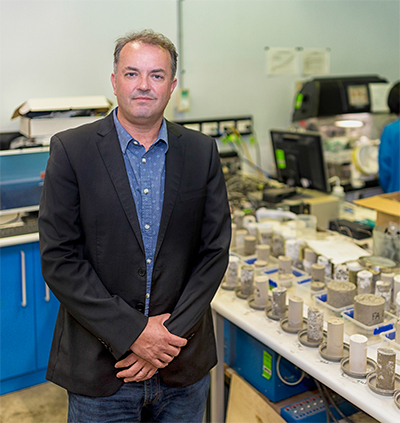21st Century materials

Concrete is the second most consumed material in the world after water, used most widely in the construction industry. The materials required for concrete - sand, gravel & water are often locally available and are relatively inexpensive. Cement is the glue that binds these aggregates together to form concrete – a relatively small amount of cement (about 14%) and Reinforcing steel (about 2-4%) are required for production of reinforced concrete.
Arnaud's leadership of the new technical committee is an important legacy of the CRC project and demonstrates the impact of our UNSW research
Professor Stephen Foster
Clinker is the primary component of cement, a dark grey nodular material made by heating ground limestone and clay at a temperature of about 1400 °C - 1500 °C. The nodules are ground up to a fine powder to produce cement, with a small amount of gypsum added to control the setting properties. Carbon emissions from the manufacture of clinker are second only to that of emissions from fossil fuels, and clinker is responsible for a significant proportion of Australia’s total greenhouse gas emissions.
In order to reduce the environmental impact of the concrete industry, Supplementary Cementitious Materials (SCMs) such as fly ash and Ground Granulated Blast-Furnace Slag (GGBFS) have been intensively used to partially replace clinker in concrete. Currently, fly ash, a widely available by-product from coal fired power stations, is the most common SCM used in Australia.
However, to address the effects of climate change, Australia has also opted to transition from fossil fuels to renewables. The shift away from coal burning to renewable energy is expected to lead to a drastic reduction in local fly ash production. The importation of millions of tonnes of fly ash every year could put the financial sustainability of the Australian concrete industry at risk.
There is an urgent need, therefore, to develop an alternative SCM available locally in suitable quantities to replace fly ash in the future. Calcined clay is a potential alternative SCM and large quantities of these clays are available in Australia. The UNSW research project led by A/Professor Arnaud Castel aims at investigating the viability of this new low carbon concrete technology. There is some sense of urgency about the project. To preserve the sustainable performance of the entire construction industry, this new concrete technology must be ready and adopted by the industry before Australia runs out of fly ash. Castel’s project will investigate the reactivity of calcined clay as a SCM in Australia. In collaboration with Dr Rackel San Nicolas at the University of Melbourne and Dr Taehwan Kim (UNSW Sydney), clays across Australia are being collected, characterised and calcined with the aim of identifying calcined clays suitable for concrete applications.
In UNSW laboratories, traditional characterisation techniques are used including Environmental Scanning Electron Microscopy (ESEM), X-Ray Diffraction (XRD) with quantitative Rietveld analysis, Fourier Transform Infrared spectroscopy (FTIR) with Attenuated Total Reflectance (ATR) attachment, thermogravimetric analysis including TGA as well as DSC, Inductively Coupled Plasma (ICP-OES) and 29Si and 27Al solid state Nuclear Magnetic Resonance spectroscopy (NMR). In addition, Automated Scanning Electron Microscopy (ASEM) combined with Data Mining Technique will allow the characterisation of the chemical and physical properties of individual calcined clay particles.
These Australian calcined clays will be used to develop Limestone Calcined Clay cement (LC3). LC3 is composed of 50% clinker, 35% calcined clay, 15 % limestone and 5% gypsum, potentially reducing the carbon footprint of cement by about 50%.
Performance-based specification of innovative construction materials is critically dependent on the ability to apply realistic and meaningful test methods. Beyond mechanical properties, the durability performance and time-dependent behaviour of Australian LC3 concretes will be assessed by Castel and his research team. The question of durability is of prime importance and is one of the main barriers to widespread adoption of new materials by the industry. Another critical aspect of reinforced concrete design is serviceability. Indeed, the control of both concrete cracking and structural member deflection is crucial. Restraint to early-age shrinkage of concrete is arguably the most common cause of unsightly cracking in concrete structures and the repair of such cracks results in high annual costs to the construction industry.
Ultimately Castel hopes to develop a new generation of performance-based standards to design durable and sustainable concrete structures. This will come in the form of a performance based handbook that will be published through Standards Australia to assist engineers and end-users in specifying and using low carbon concrete with greater confidence and less risk.
In 2018 in recognition of his expertise and leadership in the field, Associate Professor Castel has been appointed Chair of a new international Technical Committee(TC) convened by the global body, the International Union of Laboratories and Experts in Construction Materials, Systems and Structures (RILEM).
RILEM’s TC will address key questions related to the rate and mechanisms of chloride transport in alkali-activated binders and concretes, with a view toward drafting recommendations for the appropriate selection and application of testing methods. The TC will bring together the world’s leading research laboratories and practitioners in this area to ensure that decisions in the design, drafting and use of specifications, and future standards, can be built from this sound scientific basis.
The establishment of the RILEM Technical Committee is a significant milestone in the global cause of low carbon concrete. Castel’s work within the UNSW Cooperative Research Centre (CRC) for Low-Carbon Living and his research project ‘Performance based criteria for concretes: Creating pathways for low carbon concrete manufacture with existing standards’ with colleagues Professor Stephen Foster (UNSW - CVEN) and Professor Jay Sanchayan of Swinburne University, has laid the foundations for such global knowledge and sharing.
Head of School Professor Stephen Foster says that Arnaud’s leadership of the new technical committee ‘is an important legacy of the CRC project and demonstrates the impact of our UNSW research, and the respect in which it is held, internationally.’



